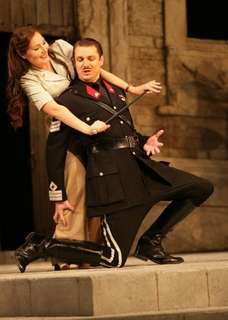|
Back
HGO Season Opener a Vocal Treat Houston
Brown Theater, Wortham Center
10/23/2009 - and October 25, 28, November 4, 7
Gaetano Donizetti: The Elixir of Love
Catherine Martin (Giannetta), John Osborn (Nemorino), Ekaterina Siurina (Adina), Liam Bonner (Belcore), Alessandro Corbelli (Dr. Dulcamara), Charles Gamble (Dr. Dulcamara’s Assistant)
Houston Grand Opera Orchestra and Chorus, Richard Bado (chorus master), Edoardo Müller (conductor)
Annabel Arden (director), Lez Brotherston (set and costume designer), Giuseppe di Iorio (lighting designer)

E. Siurina and L. Bonner (© Felix Sanchez)
Houston Grand Opera kicked off its 55th season with an effervescent performance of Donizetti’s sparkling melodramma giocoso. A true operatic bonbon, it is a wise choice to run alongside next week’s highly anticipated Lohengrin, letting the audience focus first and foremost on great singing. The two leads were sung by two excellent young singers (Osborn and Siurina) in their HGO debuts, and Liam Bonner, one of the HGO studio’s most accomplished alumni, returned to let Houston further follow his artistic development.
The first act simply doesn’t have the consistent quality and dramatic variety of the second, which is mostly Donizetti’s fault. Cast and chorus didn’t seem ultimately committed to the opera until after intermission, where the chorus’ signing became more focused and dynamically gradated. Likewise, the leads seemed to be saving themselves for their big second act arias. Osborn’s “Quanto è bella” seemed more timid than it needed to be, but he scored major points with a stunningly conceived rendition of “Una furtiva lagrima”. Likewise, Siurina’s singing in Act I seemed at times one dimensional, but she seemed refreshed, powerful and vocally confident in Act II, bringing down the house with her accurate, fearless coloratura in “Prendi, per me sei libero”, covering the aria’s two-octave range with ease.
The most consistent singing came from Bonner and Corbelli. Belcore was played as an aptly pompous, overconfident chauvinist and Bonner’s large, flexible voice and commanding stage presence made his every scene a delight, from beautifully rounded, focused tone in his lyrical arias to the rhythmically secure patter responses to Adina’s “Quanto amore!” Likewise, Corbelli was a witty, manipulative Dulcamara, hilariously shadowed by his assistant. Catherine Martin’s Gianetta was also beautifully sung, and the most impressive set piece was “Saria possibile?”, sung with delicious phrasing and gorgeous blend from the women of the HGO Chorus.
It was clear from the first downbeat that the orchestra was going to be subsidiary throughout, and this proved to be the only real disappointment of the evening. Though playing with its usual polish, the effect of the set’s acoustics on the voices made the orchestra have to play consistently at mezzo levels, disabling any attempt at dynamic impact in the surprisingly frequent intense moments in the score. The oddly raked stage, with no piece of scenery projecting the voices into the theater, resulted in less than ideal balance between stage and pit. Indeed, only when singers were down-stage did their voices truly fill the hall, and these moments were not particularly well-judged in regard to the needs of the story. There were moments when the cast would start down-stage singing a relatively unimportant phrase, then move up-stage when an aria began, causing a noticeable, and seemingly unintentional, loss of vocal presence. Müller also seemed to have trouble keeping the large ensemble pieces together, and there were a few times (notably the second scene and finale of Act I) where lack of coordination between soloists, chorus and orchestra became a distraction.
In the end, the production succeeded in doing exactly what this opera should do, and it seems curmudgeonly to mention these details in the performance that weren’t as polished as one would have hoped. With toes tapping and smiles pervading the faces of the audience, snippets of “Una furtiva lagrima” could be heard spilling out of the theater as the audience left.
Marcus Karl Maroney
|